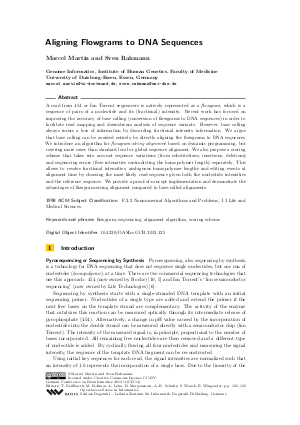Aligning Flowgrams to DNA Sequences
Authors Marcel Martin, Sven Rahmann
-
Part of:
Volume:
German Conference on Bioinformatics 2013 (GCB 2013)
Part of: Series: Open Access Series in Informatics (OASIcs) - License:
 Creative Commons Attribution 3.0 Unported license
Creative Commons Attribution 3.0 Unported license
- Publication Date: 2013-09-09
File

PDF
OASIcs.GCB.2013.125.pdf
- Filesize: 0.52 MB
- 11 pages
Document Identifiers
Subject Classification
Keywords
- flowgram
- sequencing
- alignment algorithm
- scoring scheme
Metrics
- Access Statistics
-
Total Accesses (updated on a weekly basis)
0PDF Downloads0Metadata Views
Abstract
A read from 454 or Ion Torrent sequencers is natively represented as a flowgram, which is a sequence of pairs of a nucleotide and its (fractional) intensity. Recent work has focused on improving the accuracy of base calling (conversion of flowgrams to DNA sequences) in order to facilitate read mapping and downstream analysis of sequence variants. However, base calling always incurs a loss of information by discarding fractional intensity information. We argue that base calling can be avoided entirely by directly aligning the flowgrams to DNA sequences. We introduce an algorithm for flowgram-string alignment based on dynamic programming, but covering more cases than standard local or global sequence alignment. We also propose a scoring scheme that takes into account sequence variations (from substitutions, insertions, deletions) and sequencing errors (flow intensities contradicting the homopolymer length) separately. This allows to resolve fractional intensities, ambiguous homopolymer lengths and editing events at alignment time by choosing the most likely read sequence given both the nucleotide intensities and the reference sequence. We provide a proof-of-concept implementation and demonstrate the advantages of flowgram-string alignment compared to base-called alignments.
Cite As Get BibTex
Marcel Martin and Sven Rahmann. Aligning Flowgrams to DNA Sequences. In German Conference on Bioinformatics 2013. Open Access Series in Informatics (OASIcs), Volume 34, pp. 125-135, Schloss Dagstuhl – Leibniz-Zentrum für Informatik (2013)
https://doi.org/10.4230/OASIcs.GCB.2013.125
BibTex
@InProceedings{martin_et_al:OASIcs.GCB.2013.125,
author = {Martin, Marcel and Rahmann, Sven},
title = {{Aligning Flowgrams to DNA Sequences}},
booktitle = {German Conference on Bioinformatics 2013},
pages = {125--135},
series = {Open Access Series in Informatics (OASIcs)},
ISBN = {978-3-939897-59-0},
ISSN = {2190-6807},
year = {2013},
volume = {34},
editor = {Bei{\ss}barth, Tim and Kollmar, Martin and Leha, Andreas and Morgenstern, Burkhard and Schultz, Anne-Kathrin and Waack, Stephan and Wingender, Edgar},
publisher = {Schloss Dagstuhl -- Leibniz-Zentrum f{\"u}r Informatik},
address = {Dagstuhl, Germany},
URL = {https://drops.dagstuhl.de/entities/document/10.4230/OASIcs.GCB.2013.125},
URN = {urn:nbn:de:0030-drops-42379},
doi = {10.4230/OASIcs.GCB.2013.125},
annote = {Keywords: flowgram, sequencing, alignment algorithm, scoring scheme}
}
